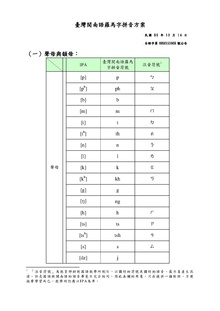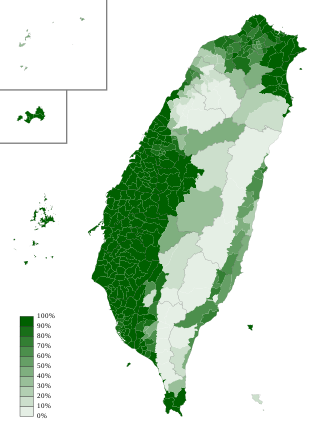
Taiwanese Hokkien, or simply Taiwanese, also known as Taiuanoe, Taigi, Taigu, Taiwanese Minnan, Hoklo and Holo, is a variety of the Hokkien language spoken natively by more than 70 percent of the population of Taiwan. It is spoken by a significant portion of those Taiwanese people who are descended from Hoklo immigrants of southern Fujian. It is one of the national languages of Taiwan.

Min is a broad group of Sinitic languages with about 70 million native speakers. These languages are spoken in Fujian province as well as by the descendants of Min-speaking colonists on the Leizhou Peninsula and Hainan and by the assimilated natives of Chaoshan, parts of Zhongshan, three counties in southern Wenzhou, the Zhoushan archipelago, Taiwan and scattered in pockets or sporadically across Hong Kong, Macau, and several countries in Southeast Asia, particularly Singapore, Malaysia, the Philippines, Indonesia, Thailand, Myanmar, Cambodia, Vietnam, Brunei. The name is derived from the Min River in Fujian, which is also the abbreviated name of Fujian Province. Min varieties are not mutually intelligible with one another nor with any other variety of Chinese.

Taibao is a county-administered city and the county seat of Chiayi County, Taiwan.
Peng'im is a Teochew dialect romanization system as a part of Guangdong Romanization published by Guangdong Provincial Education Department in 1960. The tone of this system is based on the Swatow dialect. The system uses the Latin alphabet to transcript pronunciation and numbers to note tones.
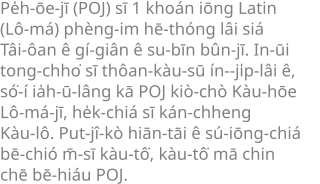
Pe̍h-ōe-jī, sometimes known as Church Romanization, is an orthography used to write variants of Hokkien Southern Min, particularly Taiwanese and Amoy Hokkien, and it is widely employed as one of the writing systems for Southern Min. During its peak, it had hundreds of thousands of readers.
Modern Literal Taiwanese (MLT), also known as Modern Taiwanese Language (MTL), is an orthography in the Latin alphabet for Taiwanese based on the Taiwanese Modern Spelling System (TMSS). MLT is able to use the ASCII character set to indicate the proper variation of pitch without any subsidiary scripts or diacritic symbols.

The National Taiwan Museum, established in 1908, is the oldest museum in Taiwan. It was founded by the colonial government during Taiwan's period of Japanese rule. The museum is located in Zhongzheng District, Taipei.

The Amoy dialect or Xiamen dialect, also known as Amoyese, Amoynese, Amoy Hokkien, Xiamenese or Xiamen Hokkien, is a dialect of Hokkien spoken in the city of Xiamen and its surrounding metropolitan area, in the southern part of Fujian province. Currently, it is one of the most widely researched and studied varieties of Southern Min. It has historically come to be one of the more standardized varieties.
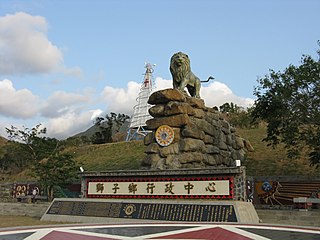
Shizi Township is a mountain indigenous township in Pingtung County, Taiwan. It is the largest township of the county. The main population is the Paiwan people of the Taiwanese aborigines.
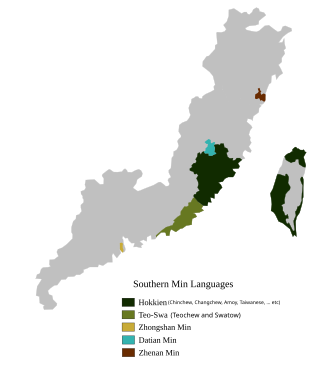
Hokkien is a variety of the Southern Min languages, native to and originating from the Minnan region, in the southeastern part of Fujian in southeastern mainland China. It is also referred to as Quanzhang, from the first characters of the urban centers of Quanzhou and Zhangzhou.

O͘o͘ is one of the six Hokkien vowels as written in the Pe̍h-ōe-jī (POJ) orthography. It is pronounced. Because Hokkien is a tonal language, the standard letter without a diacritic represents the vowel in the first tone, and the other five possible tone categories require one of the following tonal symbols to be written above it:

The Taiwan Church News is a publication of the Presbyterian Church in Taiwan. It was first published in 1885 as the Tâi-oân-hú-siâⁿ Kàu-hōe-pò under the direction of missionary Thomas Barclay, a British pastor of the Presbyterian Church, and was Taiwan's first printed newspaper, making it the longest-running newspaper in Taiwanese history. This early edition was also notable for being printed in romanised Taiwanese using the Pe̍h-ōe-jī orthography. The publication was banned during the latter stages of Japanese rule and editions were also impounded on several occasions during the martial law era in post-war Taiwan for discussing forbidden subjects. The newspaper is renowned for its use of Pe̍h-ōe-jī.
Taiwanese Language Phonetic Alphabet, more commonly known by its initials TLPA, is a romanization system for the Taiwanese Hokkien, Taiwanese Hakka, and indigenous Taiwanese languages. Based on Pe̍h-ōe-jī and first published in full in 1998, it was intended as a transcription system rather than as a full-fledged orthography.
Hokkien, a variety of Chinese that forms part of the Southern Min family and is spoken in Southeastern China, Taiwan and Southeast Asia, does not have a unitary standardized writing system, in comparison with the well-developed written forms of Cantonese and Standard Chinese (Mandarin). In Taiwan, a standard for Written Hokkien has been developed by the Ministry of Education including its Dictionary of Frequently-Used Taiwan Minnan, but there are a wide variety of different methods of writing in Vernacular Hokkien. Nevertheless, vernacular works written in Hokkien are still commonly seen in literature, film, performing arts and music.
Taiwanese Phonetic Symbols constitute a system of phonetic notation for the transcription of Taiwanese languages, especially Taiwanese Hokkien. The system was designed by Professor Chu Chao-hsiang, a member of the National Languages Committee in Taiwan, in 1946. The system is derived from Mandarin Phonetic Symbols by creating additional symbols for the sounds that do not appear in Mandarin phonology. It is one of the phonetic notation systems officially promoted by Taiwan's Ministry of Education.

The Bible translations into the languages of Taiwan are into Taiwanese, Hakka, Amis, and other languages of Taiwan.
Taiwanese Hangul is an orthography system for Taiwanese Hokkien (Taiwanese). Developed and promoted by Taiwanese linguist Hsu Tsao-te in 1987, it uses modified Hangul letters to represent spoken Taiwanese, and was later supported by Ang Ui-jin. Because both Chinese characters and Hangul are both written in the space of square boxes, unlike letters of the Latin alphabet, the use of Chinese-Hangul mixed writing is able to keep the spacing between the two scripts more consistent compared to Chinese-Latin mixed writing.
The Dictionary of Frequently-Used Taiwan Minnan is a dictionary of Taiwanese Hokkien commissioned by the Ministry of Education of Taiwan. The dictionary uses the Taiwanese Romanization System to indicate pronunciations and includes audio files for many words. As of 2013, the dictionary included entries for 20,000 words.
